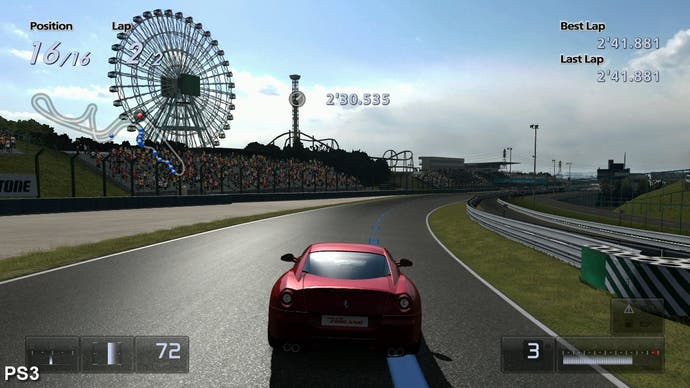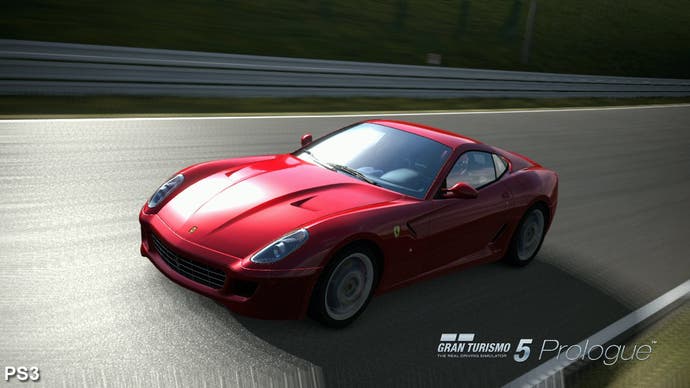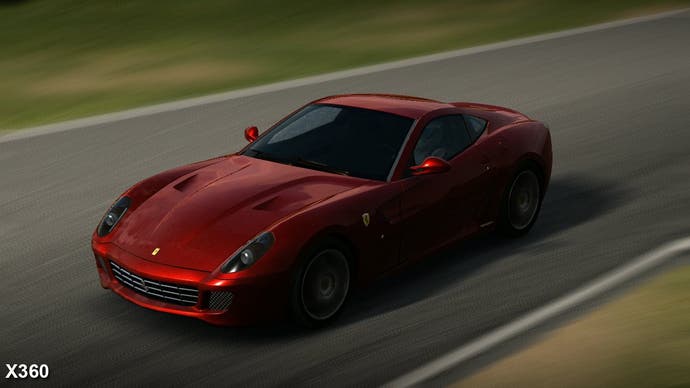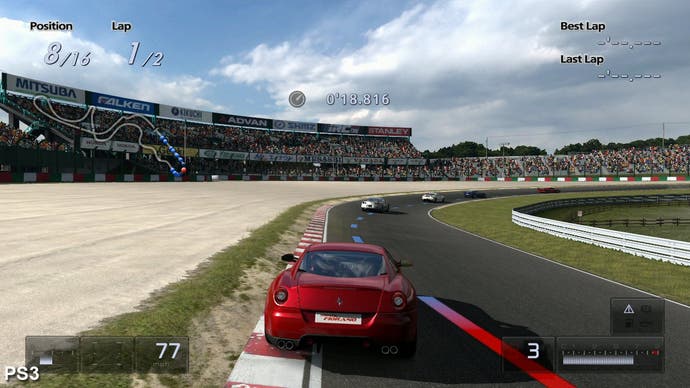Tech Evolution: Forza Motorsport 3
Forza old vs. Forza new vs. Gran Turismo.
What is curious is that, as mentioned in our initial demo analysis, filtering on ground textures such as the track itself, uses a technique known as negative LOD bias. Here, Turn 10 offers a highly detailed effect by using textures of a very high resolution, which then gets downsampled as it is displayed on-screen. The net effect of this is an excellent level of detail that comes at a cost of a shimmering moiré pattern. In theory, the use of a higher-detail texture can have performance issues, but pretty much the only real alternative would have been to implement proper anisotropic filtering, which would likely have incurred more of a performance penalty.
What you will notice is that Forza 3 rarely uses transparencies. Rendering them is very processor-intensive compared to "normal" textures - a state of affairs that becomes even more expensive computationally when tiling is in effect. In fact, the game goes out of its way to avoid using almost any sort of alpha texture, and in cases where they are used, a lower resolution buffer is used that is then scaled up. Foliage is rendered using a technique known as alpha to coverage (or A2C for short). Rather than use a traditionally transparent texture, only every other pixel is rendered, creating a "screen door" or stippled effect. This is then filtered with the MSAA mask to give some level of transparency - both Forza 2 and GT5P also use similar techniques.
Overall, in terms of the scale of the technical achievement, it's hugely impressive and can only really be topped by Turn 10's counterparts working on "the other console" over at Polyphony Digital. But more on that later.
It's no coincidence that a selection of the new levels was used for the limited demo of Forza Motorsport 3 shown at gamescom. It's also equally unsurprisingly that one of them turned up in the Xbox Live demo too. The best way to check them out at their absolute best is via the replay mode.
So, the best stages of the game showcased in the replay mode - in itself designed to show the game running at its absolute zenith. Here, Turn 10 has taken the exact same technical approach as Polyphony Digital has with Gran Turismo 5. As the player is no longer in control and ultra-precise response is not required, the engine cuts down its outputs from 60FPS down to 30. Going from drawing a frame in 16.67ms up to 33.33ms means that the developer can lavish more attention on the visuals and employ a number of special effects.
Camera and object-based motion blur is used to excellent effect, while the alpha effects omitted from the in-game mode suddenly make a reappearance in the replays. Anti-aliasing gets a boost from the standard 2x up to full 4x MSAA - effectively the very best the Xbox 360 is capable of using. The screen door/stipple effect of the A2C is still in evidence, but the MSAA sampling does a good job of covering it up to an extent. Texture filtering on the road itself still shows evidence of the negative LOD bias seen in-game, but it's clear that generally speaking the filtering is improved in the replay mode. Easily the most outstanding difference concerns the car models themselves - with twice the game to render a frame available, the higher LOD car models can be used. It is interesting to note that anything other than the "spectator cam" the replay mode defaults to reverts back to the in-game version of the engine, running at 60FPS, and using the lower LOD models for the cars.
So, with all these improvements, and all this technical accomplishment, the question is, just how close has Turn 10 come to matching the sheer coding magnificence of Polyphony Digital's Gran Turismo 5 Prologue? Make no mistake, with 52 million sales of GT games across the franchise's life-cycle, the influence of the PlayStation series on its Xbox 360 counterpart cannot be under-estimated. There is a clear sense of competition amongst the racing developers.
Right from the off, a few things need to be made abundantly clear. There is quite obviously a huge difference in the developmental focus of both firms: the Forza men ship games and don't have the leeway to decide when they actually finish a project in the way that Polyphony seemingly does.
Secondly, Turn 10 clearly does not possess the single-minded focus on technical matters that Polyphony revels in (often to the exclusion of gameplay innovations, or improvements to other important aspects, such as car AI). It's fairly self-evident that the Forza team would dedicate resources into incorporating new features as opposed to further tweaking graphics tech, and in this respect, it often leaves Polyphony to play catch up, as has been the case with the implementation of crash damage for example.
But the bottom line is that Polyphony has set the technical standard that Turn 10 has to compete against, and it's fair to say that the Japanese developers' work in GT5 will have a huge bearing on whatever form Forza 4 will take.
Both Forza 3 and GT5P do have elements in common: you can take your pick of cars that are shared across both games (we opted for the Ferrari 599) and the Suzuka race course is also found in both releases. So here's how this combo looks in both games. The Polyphony game has clear advantages in terms of lighting (improved in Forza 3, but still some way off the sophistication in GT5P), and also in edge-aliasing reduction. It's the only racing game on either platform that we've played that employs 4x MSAA and hits 60FPS. That's in 720p mode. Switch to 1080p, and you get a 50 per cent resolution boost up to 1280x1080 (expanded outwards to full HD using bilinear scaling) but AA drops to 2x MSAA. That's a pretty good trade-off, to put it lightly, and that additional 50 per cent resolution via the 1080p support does make a difference. On top of that, GT also manages to process twice the number of cars as Forza, but the grid runs with a rolling start in order to space out the vehicles. Polyphony doesn't skimp on its transparencies either. Hit the sand at speed, and the screen quickly fills with a very impressive dust cloud.
In replay mode, the differences in lighting become even more apparent, but the motion blur used by Forza is a cut above Polyphony's implementation, even if other notable effects such as a heat haze approximation are missing. The other major advantage for the Forza engine is the fact that (in-game at least), the game is v-synced and will never tear. So here's a small selection of comparison shots. One thing that must be stressed is that both games are using different time-of-day approximations, so the shots can't be used as direct like-for-like comparisons of the lighting model. Our comments here are derived from looking at the games as a whole.






Despite these technical wins for Turn 10, GT5P emerges as the classier-looking game, the standard bearer in terms of graphical accomplishment - not just up against Forza, but compared to every console driving game. Arguments about whether the 360 can or will ever match what the PS3 is achieving here will rage on forever, but, as we stressed before, clearly there are a different set of developmental priorities and resources applicable to each developer.
Turn 10 obviously wants to use those resources elsewhere, be it in implementing features like rewind, or its hugely innovative system in swapping user-generated content. Indeed, the developer is on the record in stating that these concepts are its primary focus. Refining its handling and feedback model is also a hugely important element. GT's handling was once considered unassailable, but Forza feels absolutely wonderful to control. It's difficult to comment on the exact technical characteristics of the handling in either game, but one thing that is certain is that whatever success Forza has here is entirely down to Turn 10's own endeavours. The handling model is no carbon copy of GT's: one lap of the Suzuka circuit in the Ferrari 599 on both games feels almost completely different. Without having a real-life Ferrari to hand, it's impossible to tell which is the more realistic, but the question really should be, to what extent does it actually matter if it feels right, and you're having fun?
